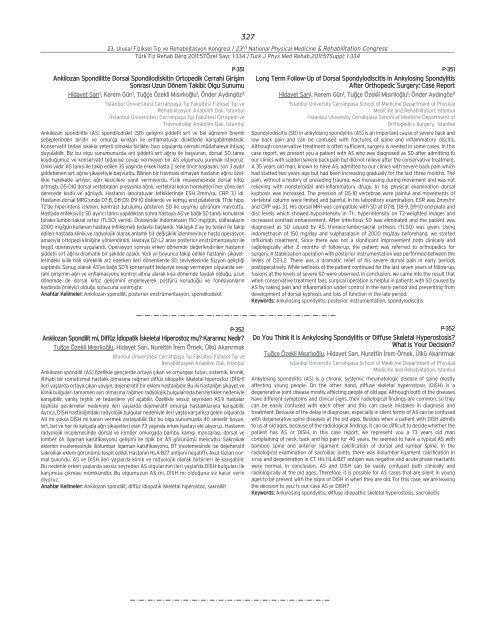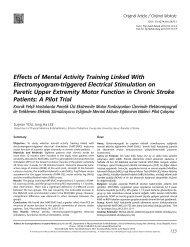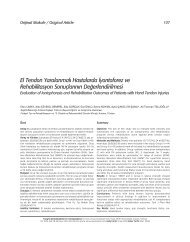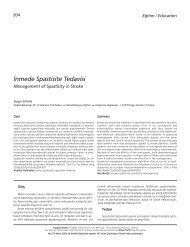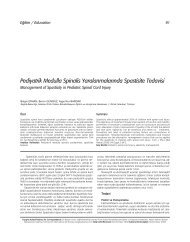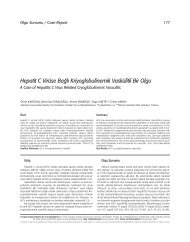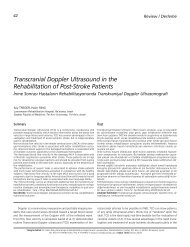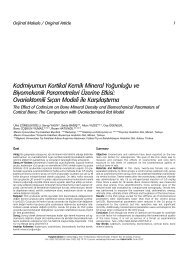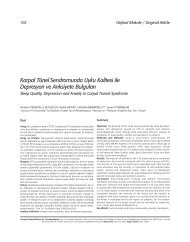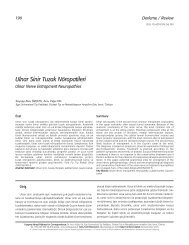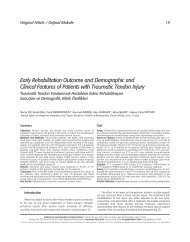Postmenopozal Kad›nlarda Vücut Kitle ‹ndeksinin ... - FTR Dergisi
Postmenopozal Kad›nlarda Vücut Kitle ‹ndeksinin ... - FTR Dergisi
Postmenopozal Kad›nlarda Vücut Kitle ‹ndeksinin ... - FTR Dergisi
You also want an ePaper? Increase the reach of your titles
YUMPU automatically turns print PDFs into web optimized ePapers that Google loves.
P-351<br />
Ankilozan Spondilitte Dorsal Spondilodiskitin Ortopedik Cerrahi Giriflim<br />
Sonras› Uzun Dönem Takibi: Olgu Sunumu<br />
Hidayet Sar› 1, Kerem Gün 1, Tu¤çe Özekli M›s›rl›o¤lu 1, Önder Ayd›ngöz 2<br />
1 ‹stanbul Üniversitesi Cerrahpafla T›p Fakültesi Fiziksel T›p ve<br />
Rehabilitasyon Anabilim Dal›, ‹stanbul<br />
2 ‹stanbul Üniversitesi Cerrahpafla T›p Fakültesi Ortopedi ve<br />
Travmatoloji Anabilim Dal›, ‹stanbul<br />
Ankilozan spondilitte (AS) spondilodiskit (SD) geliflimi fliddetli s›rt ve bel a¤r›s›n›n önemli<br />
sebeplerinden biridir ve omurga k›r›klar› ile enflamatuvar diskitlerle kar›flabilmektedir.<br />
Konservatif tedavi s›kl›kla yeterli olmakla birlikte, baz› olgularda cerrahi müdahaleye ihtiyaç<br />
duyulabilir. Biz bu olgu sunumunuzda ani fliddetli s›rt a¤r›s› ile baflvuran, dorsal SD tan›s›<br />
koydu¤umuz ve konservatif tedaviye cevap vermeyen bir AS olgumuzu sunmak istiyoruz.<br />
Oniki y›ld›r AS tan›s› ile takip edilen 35 yafl›nda erkek hasta 2 sene önce bafllayan, son 3 ayd›r<br />
fliddetlenen s›rt a¤r›s› flikayetiyle baflvurdu. Bilinen bir travmas› olmayan hastan›n a¤r›s› özellikle<br />
hareketle art›yor, a¤r› kesicilere yan›t vermiyordu. Fizik muayenesinde dorsal kifoz<br />
artm›flt›. D5-D10 dorsal vertebralar› presyonla a¤r›l›, vertebral kolon hareketleri her yöne ileri<br />
derecede k›s›tl› ve a¤r›l›yd›. Hastan›n laboratuvar tetkiklerinde ESH 2mm/sa, CRP 3,1 idi.<br />
Hastan›n dorsal MRG’sinde D7-8, D8-D9, D9-10 disklerde ve komflu end platelerde T1’de hipo,<br />
T2’de hiperintens izlenen, kontrast tutulumu gösteren SD ile uyumlu görünüm mevcuttu.<br />
Hastada enfeksiyöz SD ay›r›c› tan›s› yap›ld›ktan sonra hastaya AS’ye ba¤l› SD tan›s› konularak<br />
torako-lumbo-sakral ortez (TLSO) verildi. Öncesinde indometasin 150 mg/gün, sülfasalazin<br />
2000 mg/gün kullanan hastaya infliksimab tedavisi baflland›. Yaklafl›k 2 ay bu tedavi ile takip<br />
edilen hastada klinik ve radyolojik olarak anlaml› bir de¤ifliklik izlenmeyince hasta operasyon<br />
amac›yla ortopedi klini¤ine yönlendirildi. Hastaya D2-L2 aras› posterior enstrümentasyon ile<br />
tespit operasyonu uyguland›. Operasyon sonras› erken dönemde de¤erlendirilen hastan›n<br />
fliddetli s›rt a¤r›s› dramatik bir flekilde azald›. Yedi y›l boyunca takip edilen hastan›n flikayetlerindeki<br />
iyilik hali süreklilik arz ederken ileri dönemlerde SD seviyelerinde füzyon geliflti¤i<br />
saptand›. Sonuç olarak AS’ye ba¤l› SD’li konservatif tedaviye cevap vermeyen olgularda cerrahi<br />
giriflimin a¤r› ve enflamasyonu kontrol alt›na alarak k›sa dönemde faydal› oldu¤u, uzun<br />
dönemde de dorsal kifoz geliflimini engelleyerek postürü korudu¤u ve fonksiyonlar›n<br />
kayb›nda önleyici oldu¤u sonucuna var›lm›flt›r.<br />
Anahtar Kelimeler: Ankilozan spondilit, posterior enstrümentasyon, spondilodiskit<br />
P-352<br />
Ankilozan Spondilit mi, Diffüz ‹diopatik ‹skeletal Hiperostoz mu? Karar›n›z Nedir?<br />
Tu¤çe Özekli M›s›rl›o¤lu, Hidayet Sar›, Nurettin ‹rem Örnek, Ülkü Akar›rmak<br />
‹stanbul Üniversitesi Cerrahpafla T›p Fakültesi Fiziksel T›p ve<br />
Rehabilitasyon Anabilim Dal›, ‹stanbul<br />
Ankilozan spondilit (AS) özellikle gençlerde ortaya ç›kan ve omurgay› tutan, sistemik, kronik,<br />
iltihabi bir romatizmal hastal›k olmas›na ra¤men diffüz idiopatik iskeletal hiperostoz (D‹SH)<br />
ileri yafllarda ortaya ç›kan yayg›n, dejeneratif bir eklem hastal›¤›d›r. Bu iki hastal›¤›n flikayet ve<br />
klinik bulgular› tamamen ayr› olmas›na ra¤men radyolojik bulgular›nda benzerlikler nedeniyle<br />
kar›flabilir, yanl›fl teflhis ve tedavilere yol açabilir. Özellikle sessiz seyreden AS’li hastalar<br />
teflhiste gecikmeler nedeniyle ileri yafllarda dejeneratif omurga hastal›klar›yla kar›flabilir.<br />
Ayr›ca, D‹SH hastal›¤›ndaki radyolojik bulgular nedeniyle ileri yaflta karfl›m›za gelen olgularda<br />
AS mi yoksa D‹SH mi karar› vermek zorlaflabilir. Biz bu olgu sunumuzda 40 senedir boyun,<br />
s›rt, bel ve her iki kalçada a¤r› flikayetleri olan 73 yafl›nda erkek hastay› ele al›yoruz. Hastan›n<br />
radyolojik incelemesinde dorsal ve lomber omurgada bambu kam›fl› manzaras›, dorsal ve<br />
lomber ön ligaman kalsifikasyonu geliflimi ile tipik bir AS görünümü mevcuttu. Sakroiliak<br />
eklemin incelemesinde iliolumbar ligaman kalsifikasyonu, BT incelemesinde ise dejeneratif<br />
sakroiliak eklem görünümü tespit edildi. Hastan›n HLA-B27 antijeni negatifti. Akut fazlar› normal<br />
bulundu. AS ve D‹SH ileri yafllarda klinik ve radyolojik olarak birbirleri ile kar›flabilir.<br />
Bu nedenle erken yafllarda sessiz seyreden AS olgular›n›n ileri yafllarda D‹SH bulgular› ile<br />
karfl›m›za ç›kmas› mümkündür. Bu olgumuzun AS mi, D‹SH mi oldu¤una siz karar verin<br />
diyoruz.<br />
Anahtar Kelimeler: Ankilozan spondilit, diffüz idiopatik iskeletal hiperostoz, sakroiliit<br />
327<br />
23. Ulusal Fiziksel T›p ve Rehabilitasyon Kongresi / 23 rd National Physical Medicine & Rehabilitation Congress<br />
Türk Fiz Rehab Derg 2011:57Özel Say›; 1-334 /Turk J Phys Med Rehab 2011:57Suppl; 1-334<br />
P-351<br />
Long Term Follow-Up of Dorsal Spondylodiscitis in Ankylosing Spondylitis<br />
After Orthopedic Surgery: Case Report<br />
Hidayet Sar› 1, Kerem Gün 1, Tu¤çe Özekli M›s›rl›o¤lu 1, Önder Ayd›ngöz 2<br />
1 Istanbul University Cerrahpasa School of Medicine Department of Physical<br />
Medicine and Rehabilitation, Istanbul<br />
2 Istanbul University Cerrahpasa School of Medicine Department of<br />
Orthopedics Surgery, Istanbul<br />
Spondylodiscitis (SD) in ankylosing spondylitis (AS) is an important cause of severe back and<br />
low back pain and can be confused with fractures of spine and inflammatory discitis.<br />
Although conservative treatment is often sufficient, surgery is needed in some cases. In this<br />
case report, we present you a patient with AS who was diagnosed as SD after admitting to<br />
our clinics with sudden severe back pain but did not relieve after the conservative treatment.<br />
A 35 years old man, known to have AS, admitted to our clinics with severe back pain which<br />
had started two years ago but had been increasing gradually for the last three months. The<br />
pain, without a history of preceding trauma, was increasing during movement and was not<br />
relieving with nonsteroidal anti-inflammatory drugs. In his physical examination dorsal<br />
kyphosis was increased. The pression of D5-10 vertebrae were painful and movements of<br />
vertebral column were limited and painful. In his laboratory examination, ESR was 2mm/hr<br />
and CRP was 3.1. His dorsal MRI was compatible with SD at D7-8, D8-9, D9-10 end-plate and<br />
disc levels which showed hypointensity in T1-, hyperintensity on T2-weighted images and<br />
increased contrast enhancement. After infectious SD was eliminated and the patient was<br />
diagnosed as SD caused by AS, thoraco-lumbo-sacral orthesis (TLSO) was given. Using<br />
indomethasin of 150 mg/day and sulphasalasin of 2000 mg/day beforehand, we started<br />
infliximab treatment. Since there was not a significant improvement both clinically and<br />
radiologically after 2 months of follow-up, the patient was referred to orthopedics for<br />
surgery. A stabilization operation with posterior instrumentation was performed between the<br />
levels of D2-L2. There was a dramatic relief of his severe dorsal pain in early periods<br />
postoperatively. While wellness of the patient continued for the last seven years of follow-up,<br />
fusions at the levels of severe SD were observed. In conclusion, we came into the result that<br />
when conservative treatment fails, surgical operation is helpful in patients with SD caused by<br />
AS by taking pain and inflammation under control in the early period and preventing from<br />
development of dorsal kyphosis and loss of function in the late period.<br />
Keywords: Ankylosing spondylitis, posterior instrumentation, spondylodiscitis<br />
P-352<br />
Do You Think it is Ankylosing Spondylitis or Diffuse Skeletal Hyperostosis?<br />
What is Your Decision?<br />
Tu¤çe Özekli M›s›rl›o¤lu, Hidayet Sar›, Nurettin ‹rem Örnek, Ülkü Akar›rmak<br />
Istanbul University Cerrahpasa School of Medicine Department of Physical<br />
Medicine and Rehabilitation, Istanbul<br />
Ankylosing spondylitis (AS) is a chronic systemic rheumatologic disease of spine mostly<br />
affecting young people. On the other hand, diffuse skeletal hyperostosis (DISH) is a<br />
degenerative joint disease mostly affecting people of old age. Although both of the diseases<br />
have different symptoms and clinical signs, their radiological findings are common, so they<br />
can be easily confused with each other and this can cause mistakes in diagnosis and<br />
treatment. Because of the delay in diagnoses, especially in silent forms of AS can be confused<br />
with degenerative spine diseases at the old ages. Besides when a patient with DISH admits<br />
to us at old ages, because of the radiological findings, it can be difficult to decide whether the<br />
patient has AS or DISH. In this case report, we represent you a 73 years old man<br />
complaining of neck, back and hip pain for 40 years. He seemed to have a typical AS with<br />
bamboo spine and anterior ligament calcification of dorsal and lumbar spine. In the<br />
radiological examination of sacroiliac joints, there was iliolumbar ligament calcification in<br />
x-ray and degeneration in CT. His HLA-B27 antigen was negative and acute phase reactants<br />
were normal. In conclusion, AS and DISH can be easily confused both clinically and<br />
radiologically at the old ages. Therefore, it is possible for AS cases that are silent in young<br />
ages to be present with the signs of DISH in when they are old. For this case, we are leaving<br />
the decision to you: Is our case AS or DISH?<br />
Keywords: Ankylosing spondylitis, diffuse idiopathic skeletal hyperostosis, sacroileitis


